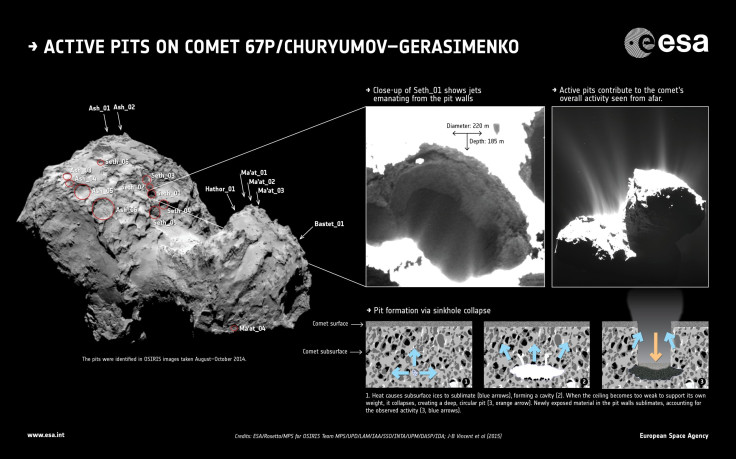Rosetta Finds Sinkhole-Like Pits On Comet 67P Generating Dust Jets

The European Space Agency’s (ESA) Rosetta spacecraft, whose comet-chasing mission was recently extended until the end of September 2016, has come up with a new discovery about the Comet 67P/Churyumov-Gerasimenko. Rosetta, which was launched in 2004, has found active pits -- similar to “sinkholes” -- that are responsible for a number of dust jets emerging from the comet’s surface.
The pits that are likely formed by a sudden collapse of the comet’s surface are expected to help astronomers better understand the chaotic and diverse interior of the Comet 67P, scientists said in a study, published in the journal Nature on Wednesday. Ever since it reached the comet last August, and subsequently deployed the Philae lander on Nov. 12, Rosetta has been monitoring how the comet’s corona of dust and gas grows as it moves closer to the sun, according to ESA.
“We see jets arising from the fractured areas of the walls inside the pits,” Jean-Baptiste Vincent from the Max Planck Institute for Solar System Research, and the study’s lead author, said in a statement on Wednesday. “These fractures mean that volatiles trapped under the surface can be warmed more easily and subsequently escape into space.”
Rosetta previously observed a complex pattern of the dust jets emitted from the nucleus of the comet. But as part of the latest findings, the spacecraft has managed to take high-resolution images from a much closer distance, helping astronomers trace the dust jets to specific locations on Comet 67P’s surface for the first time.
Scientists believe that the pits are formed when the ceiling of a subsurface cavity becomes too thin to support its own weight and collapses.
“The pits are a few tens to a few hundreds of meters in diameter and extend up to 210 m below the surface to a smooth dust-covered floor. Material is seen to be streaming from the most active pits,” according to ESA.
Comet 67P/Churyumov-Gerasimenko will make its closest approach to the sun on Aug. 13, during which scientists are expected to move Rosetta much closer to the comet’s nucleus for a more detailed survey.
© Copyright IBTimes 2024. All rights reserved.






















